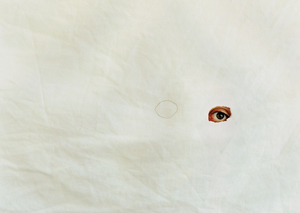This is an archive of the ArtCat Zine, 2007-2009. Please visit our new project, IDIOM.
31 Takes
31 under 31
Curated by Lumi Tan and Jonathan Feinstein
3rd Ward - 195 Morgan Ave Brooklyn NY
1 March - 28 March 2008
If we need a month to commemorate the achievements of women across cultures and generations, then it’s only fitting that an exhibition should sometimes fall under a thematic conception as loose as this month’s dedication. 31 Under 31, currently on view at 3rd Ward, is an exhibition that brings thirty-one women under the age of thirty-one to show one photograph each. Though a vast and expansive criteria and an equally vague thematic structure, curators Lumi Tan and Jonathan Feinstein have selected thirty-one impressive and striking photographs that proudly display the talent and astute vision of thirty-one very different young women. The parameters of sex and age have nothing to do with artistic skill, personal taste or creative vision and yet, when given these basic guidelines under which an artist can showcase her work, the end result is clearly multifarious and wildly eclectic, which lends itself well for photographic interpretations. Because an age group cannot reflect an aesthetic predisposition and because age can only speak about the number of years passed, all the other personal motivations for every photograph presented are as different from the next as each photographer’s background and personal history.
Is a photographer guided in his vision by gender? That very notion may be a facile generalization dismissed by the discourse upon which contemporary art today is based. After all, if a woman’s lens were to convey any particular group ethos, it would be lumped into an unfair category based on irrefutable facts with no consideration for aesthetic position. 31 Under 31 presents nothing more than the photographic ideas, disparate and eclectic, from thirty-one individual women. Whether or not it helps us to understand our generation from these thirty-one individual conceptions of their time remains uncertain. Perhaps, it is not fair to claim that this generation is a reflection of a certain modern contemporary vision. After all, some images are conceptual and stylized, while others more documentary. Regardless, no singular collective voice pervades but rather a basic criteria dictated by the exhibition's title. If, however, there is no collective voice then it’s thirty-one voices that present thirty terse impressions of today. There is no sense of female collaboration or collective cries of solidarity; any such suggestions would be disingenuous. Rather, we have a fresh look at young photographers selected out of a huge number of submissions for their originality and skill. Their unique gazes, the skill of each carefully constructed image and the exploration of their subject matter are the essential points that, together, present thirty-one testaments to the way a world looks thirty-one ways at a time.
Dru Donavan’s ethereal photograph is a painterly image of a person floating in water. Reminiscent of a baptism, the picture depicts a figure amidst ripples of waves, the body submerged with a white, gossamer layer of water that conceals everything except a bright red t-shirt and hints of limbs and a head. The figure's unique stance creates an angle that positions the photographer in the foreground, as though she is the force that casts the light upon this floating body. Rachael Dunville’s image of a young family on a porch meanwhile is as honest and forthright as it is sad and abject. We don’t know their story, their names, or where they come from and yet the narrative of their life seems strangely familiar, like a Gus Van Sant film in which the kids are young, white and from anywhere, USA, jaded and disaffected just like their entire generation.
Jaimie Warren’s image, Untitled (Naoko Squid Teeth) is funny and intimate in its inspection of, most probably, a friend’s after-thoughts on an obvious feast. We see all the details of Naoko’s face around her large, ink-stained grin. Every grimy detail reeks of a candid satisfaction following this girl’s indulgent meal and the souvenirs retained. At first slightly repulsive — that is, seeing black shit on white teeth and pink gums — each detail of the image, upon reconsideration, presents a delectable, satisfying remnant of this well documented meal that we don’t need to see to understand. Perhaps the picture's polar opposite in the show is the contemplative image of Talia Cherit whose perfect glimmer of flight shows us the way we want our spring to look when it comes.
Her faint, barely visible rainbow on a bright white surface is an impressive collection of light. If seen with too much daylight, her rainbow isn’t noticeable at all and, just like a real rainbow, can really only make sense in a cloudy afterthought. Next to it is Kelly Kleinschrodt’s wounded balloon, another afterthought to a seemingly perfect thing. The balloon is caught in its still undisturbed wholeness, with a small punctured hole from an inserted needle and a growing puddle from the water contained inside. This image is the documentation of a deliberate act, with its premeditated plan and obvious sense of immediacy. It’s also really pretty. Finally, Dina Kantor’s Keren photograph shows a little girl whose perfect girl-child world is the fantastic reality of this busy image. A little girl stands on her head in her unbearably pink room, replete with all the perfect toys she could ever want. A tiny ballerina who dreams of all the perfect things that pink, heart-shaped pillows, ballet shoes and plush rocking horses make possible but only in her room and only for a while.
ZINE
HOME
TIPS / COMMENTS
CATEGORIES
CONTRIBUTORS
- Greg Afinogenov
- B. Blagojevic
- Adda Birnir
- Susannah Edelbaum
- Julie Fishkin
- Paddy Johnson
- Jessica Loudis
- Christopher Reiger
- Andrew Robinson
- Peter J. Russo
- Blythe Sheldon
- S.C.Squibb
- Hrag Vartanian

